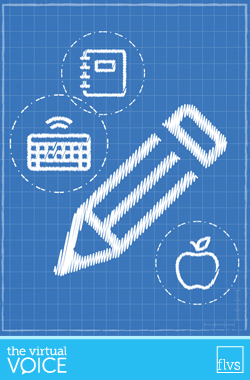Blueprints for Building Community
 When I share with people (especially those who are teaching in traditional classrooms) that I’ve shifted into high gear preparing for a new year with my students, I must admit, I’ve gotten a lot of puzzled looks and questions, like “What exactly do you need to do? I mean, you teach virtually.”
When I share with people (especially those who are teaching in traditional classrooms) that I’ve shifted into high gear preparing for a new year with my students, I must admit, I’ve gotten a lot of puzzled looks and questions, like “What exactly do you need to do? I mean, you teach virtually.”
Before I answer (or take offense), I take a relaxed breath and smile.
Because, like them, exactly one year ago, I didn’t have a clue.
So how do virtual elementary teachers prepare for a new crop of eager learners? Luckily, for all the new teachers just starting this adventure, the blueprint is surprisingly similar to a brick-and-mortar school. The 2016-17 year kicked off this past week by building community.
In his book Life in a Crowded Place, Ralph Peterson sums it up so well:
“Teachers who make communities with their students are cultural engineers of sorts. The primary goal at the beginning of a new year or term is to lead students to come together, form a group, and be there for one another.”
Here at FLVS, we begin by making our Welcome Calls, the official phone call where we share what our program has to offer, go over expectations, answer questions, etc. But more importantly, we begin to know our parents, all home educators. Many, like my newest colleagues, are also taking this on for the first time.
We seize the opportunity to speak with our students…find out what kind of books they like, what they like to do when they’re not doing schoolwork, and sometimes we get to hear what they want out of this school year.
I laugh when I hear people talk about groupies — defined by most as people who follow a celebrity in hopes of meeting them. I felt like I might get that label several years ago, because I would look for Shelley Harwayne in the program of any literacy conference and make sure to attend her session, front and center, if possible. At the time, she was director of the Manhattan New School and shared that their 500 students represented 35 cultures and almost that many different languages.
It certainly was for those teachers (and with our diverse group of families and students, is for us now) very important to be cultural engineers. At one of those conference sessions, I remember hearing her so clearly…community-building doesn’t begin with the students but with the adults, starting with our colleagues. I’ve heard our principal, Sarah Sprinkel, share this Teddy Roosevelt quote many times:

This circles back to building community. Ralph Peterson refers to community as “Making a Caring Place.” How do we do that in the virtual classroom? How do we do this with our colleagues?
Going back to the puzzled looks and questions about setting up and arranging a classroom (and maybe because I’ve been lesson planning for third grade with a heavy emphasis on map work in social studies) makes me think of geography and my favorite beginning-of-the-year thoughts on the importance of setting up the classroom.
In brick-and-mortar schools, this means everything from arranging the furniture to making sure the spaces match the different learning approaches you want to incorporate. But those thoughts are old thoughts, ones I had before I started teaching with FLVS. Now I see that designing classroom space is part of all blueprints. At FLVS, it’s creating slides with standards-based content that is also interactive and engaging. It’s getting the most out of Class Time when we greet children with a brain warm-up in our virtual classrooms. It’s keeping them on their toes by effectively interacting with different tools as we explore the content.
I will end with a quote from Isabel Beaton, because I believe it’s a good start to the beginning of our school year as virtual teachers. I realize now, her words don’t just refer to the traditional physical environment and are important for every teacher to include in their own individual classroom blueprints:
“Geography is everything. I realized that I needed to figure out what I wanted to happen and how my classroom geography could support and enhance—or inhibit and deter—those goals. A country’s geography predetermine a lot of what goes on in that country—for example, rivers and mountains form natural barriers and then people/society put up others: a railroad cut, a highway, a wall. But in my classroom, I determine the geography. I can put up barriers to communication or I can set things up to encourage conversation. I can establish lonely islands of I’s or I can form communities and provinces of we’s. Everyone can have his or her own of each thing or groups can share. I can make that sharing difficult or I can support it. All the energy in my room can come from me or I can have constellations of energy. And the geography I put in place with do that for me.” – Isabel Beaton
Image credit: Elegant WordArt by Bethany
Post by: Nancy Jo Mannix, Former FLVS 1st Grade Teacher
